The AI Tipping Point: How XAI, TWG, and Palantir Are Transforming Financial Services
The financial services industry is at a crossroads. Despite decades of technological advancements, 74% of companies remain mired in the proof-of-concept phase of AI adoption, unable to translate cutting-edge tools into measurable business outcomes. Enter a groundbreaking collaboration: xAI,
, and Palantir Technologies have formed a coalition to embed AI into the core of enterprise operations, promising to break through the “agentic tech debt bubble” and unlock productivity gains long elusive to the sector.At its heart, this partnership merges three critical strengths: xAI’s supercomputing prowess (via its Colossus infrastructure), Palantir’s enterprise-grade software platforms, and TWG’s operational know-how. Together, they aim to deliver a scalable, outcome-based AI solution that transforms legacy systems, streamlines workflows, and creates new revenue streams—all within 90 days.

The Problem: AI’s Productivity Paradox
The disconnect between AI potential and real-world returns is stark. Companies invest billions in AI tools, only to see them languish in pilot phases or produce fragmented, low-impact results. Drew Cukor, TWG’s Head of Data and Analytics, dubs this the “agentic tech debt bubble”—a cycle of rushed, siloed AI projects that fail to align with strategic goals. The result? A $1.2 trillion opportunity cost annually for global enterprises.
The Solution: A Three-Legged Stool
The coalition’s framework addresses this through three pillars:
1. Governance Foundation: Ensures data readiness, security, and governance for large-scale AI orchestration.
2. Agent Suite: Industry-tailored tools to democratize knowledge and boost productivity.
3. Agentic Workforce: A modular army of AI agents trained to automate revenue generation, cost reduction, and cross-functional processes.
TWG’s role is pivotal: they act as the “integrator,” working directly with CEOs and C-suite leaders to deploy hundreds of thousands of AI agents across the enterprise. These agents operate with military-grade security, enabling firms to scale operations, enter new markets, and modernize outdated systems—all while avoiding the pitfalls of disjointed AI investments.
The Financial Case: Palantir’s Momentum
The partnership’s viability is underscored by Palantir’s recent performance. . In Q1 2025, Palantir reported a 75% surge in U.S. commercial revenue, pushing total contract value to $810 million. Analysts are taking notice: DA Davidson raised its price target to $115, citing the firm’s ability to secure large-scale deals, while Morgan Stanley and Mizuho also upgraded their outlooks.
Even skeptics must acknowledge Palantir’s financial fortitude. With a current ratio of 5.96 and a minimal debt-to-equity ratio of 0.05, the company is positioned to weather market volatility while scaling this ambitious initiative.
Risks and Realities
No innovation is risk-free. The partnership faces hurdles, including misaligned customer needs and software performance failures. Yet the outcome-based pricing model—a first in enterprise AI—shifts risk to the coalition. Instead of traditional licensing fees, success hinges on measurable P&L impacts, incentivizing the group to deliver results or face financial consequences.
Why This Matters for Investors
The stakes are enormous. Financial services firms collectively spend $140 billion annually on IT, yet only 26% achieve AI-driven ROI. This partnership targets that inefficiency directly. By embedding AI at the core of operations—rather than as a peripheral tool—the coalition could redefine competitive advantage.
Consider the numbers:
- Palantir’s enterprise software has already helped J.P. Morgan reduce operational costs by 15%.
- TWG’s prior military-grade AI programs achieved 90% agent utilization rates within 120 days.
- xAI’s Colossus supercomputer processes data at speeds unmatched in the commercial sector.
Combined, these capabilities could slash integration timelines from years to months and turn AI from a cost center into a profit driver.
Conclusion: A New Era for Enterprise AI
The XAI-TWG-Palantir alliance represents more than a business deal—it’s a strategic bet on AI’s transformative potential. With Palantir’s financial heft, TWG’s implementation expertise, and xAI’s technical brilliance, they’re tackling the industry’s most stubborn barriers to AI adoption.
For investors, the partnership offers dual opportunities:
1. Sector leadership: Palantir’s stock, trading at a 25% discount to its $115 analyst target, could surge as the initiative gains traction.
2. Thematic upside: The coalition’s outcome-based model sets a template for industries beyond finance, from healthcare to manufacturing.
The data is clear: companies that fail to operationalize AI risk obsolescence. For those willing to embrace this collaboration, the rewards—faster growth, higher margins, and sustainable competitive edges—are within reach. In the 21st century’s productivity race, this trio has just handed enterprises a head start.

Comments
No comments yet